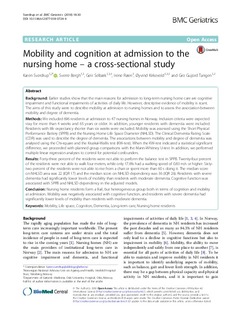| dc.contributor.author | Sverdrup, Karen | |
| dc.contributor.author | Bergh, Sverre | |
| dc.contributor.author | Selbæk, Geir | |
| dc.contributor.author | Røen, Irene Mari | |
| dc.contributor.author | Kirkevold, Øyvind | |
| dc.contributor.author | Tangen, Gro Gujord | |
| dc.date.accessioned | 2018-09-11T09:15:36Z | |
| dc.date.available | 2018-09-11T09:15:36Z | |
| dc.date.created | 2018-01-30T13:46:22Z | |
| dc.date.issued | 2018 | |
| dc.identifier.citation | BMC Geriatrics. 2018, 18 (30), . | nb_NO |
| dc.identifier.issn | 1471-2318 | |
| dc.identifier.uri | http://hdl.handle.net/11250/2561941 | |
| dc.description.abstract | Background
Earlier studies show that the main reasons for admission to long-term nursing home care are cognitive impairment and functional impairments of activities of daily life. However, descriptive evidence of mobility is scant. The aims of this study were to describe mobility at admission to nursing homes and to assess the association between mobility and degree of dementia.
Methods
We included 696 residents at admission to 47 nursing homes in Norway. Inclusion criteria were expected stay for more than 4 weeks and 65 years or older. In addition, younger residents with dementia were included. Residents with life expectancy shorter than six weeks were excluded. Mobility was assessed using the Short Physical Performance Battery (SPPB) and the Nursing Home Life Space Diameter (NHLSD). The Clinical Dementia Rating Scale (CDR) was used to describe the degree of dementia. The associations between mobility and degree of dementia was analysed using the Chi-square and the Kruskal-Wallis test (KW-test). When the KW-test indicated a statistical significant difference, we proceeded with planned group comparisons with the Mann-Whitney U-test. In addition, we performed multiple linear regression analyses to control for potential confounders.
Results
Forty-three percent of the residents were not able to perform the balance test in SPPB. Twenty-four percent of the residents were not able to walk four meters, while only 17.6% had a walking speed of 0.83 m/s or higher. Sixty-two percent of the residents were not able to rise from a chair or spent more than 60 s doing it. The median score on NHLSD area was 22 (IQR 17) and the median score on NHLSD dependency was 36 (IQR 26). Residents with severe dementia had significantly lower levels of mobility than residents with moderate dementia. Cognitive function was associated with SPPB and NHLSD dependency in the adjusted models.
Conclusion
Nursing home residents form a frail, but heterogeneous group both in terms of cognition and mobility at admission. Mobility was negatively associated with cognitive function, and residents with severe dementia had significantly lower levels of mobility than residents with moderate dementia. | nb_NO |
| dc.language.iso | eng | nb_NO |
| dc.publisher | BMC (part of Springer Nature) | nb_NO |
| dc.rights | Navngivelse 4.0 Internasjonal | * |
| dc.rights.uri | http://creativecommons.org/licenses/by/4.0/deed.no | * |
| dc.title | Mobility and cognition at admission to the nursing home – a cross-sectional study | nb_NO |
| dc.type | Journal article | nb_NO |
| dc.type | Peer reviewed | nb_NO |
| dc.description.version | publishedVersion | nb_NO |
| dc.source.pagenumber | 8 | nb_NO |
| dc.source.volume | 18 | nb_NO |
| dc.source.journal | BMC Geriatrics | nb_NO |
| dc.source.issue | 30 | nb_NO |
| dc.identifier.doi | 10.1186/s12877-018-0724-4 | |
| dc.identifier.cristin | 1556493 | |
| dc.description.localcode | © The Author(s). 2018 Open Access This article is distributed under the terms of the Creative Commons Attribution 4.0 International License (http://creativecommons.org/licenses/by/4.0/) | nb_NO |
| cristin.unitcode | 194,65,70,0 | |
| cristin.unitname | Institutt for helsevitenskap Gjøvik | |
| cristin.ispublished | true | |
| cristin.fulltext | original | |
| cristin.qualitycode | 1 | |

